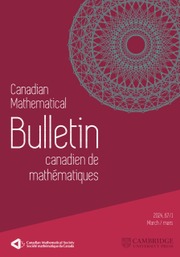Article contents
C*-Algebras Associated with Mauldin–Williams Graphs
Published online by Cambridge University Press: 20 November 2018
Abstract
A Mauldin–Williams graph  $M$ is a generalization of an iterated function system by a directed graph. Its invariant set
$M$ is a generalization of an iterated function system by a directed graph. Its invariant set  $K$ plays the role of the self-similar set. We associate a
$K$ plays the role of the self-similar set. We associate a  ${{C}^{*}}$ -algebra
${{C}^{*}}$ -algebra  ${{O}_{M}}\left( K \right)$ with a Mauldin–Williams graph
${{O}_{M}}\left( K \right)$ with a Mauldin–Williams graph  $M$ and the invariant set
$M$ and the invariant set  $K$ , laying emphasis on the singular points. We assume that the underlying graph
$K$ , laying emphasis on the singular points. We assume that the underlying graph  $G$ has no sinks and no sources. If
$G$ has no sinks and no sources. If  $M$ satisfies the open set condition in
$M$ satisfies the open set condition in  $K$ , and
$K$ , and  $G$ is irreducible and is not a cyclic permutation, then the associated
$G$ is irreducible and is not a cyclic permutation, then the associated  ${{C}^{*}}$ -algebra
${{C}^{*}}$ -algebra  ${{O}_{M}}\left( K \right)$ is simple and purely infinite. We calculate the
${{O}_{M}}\left( K \right)$ is simple and purely infinite. We calculate the  $K$ -groups for some examples including the inflation rule of the Penrose tilings.
$K$ -groups for some examples including the inflation rule of the Penrose tilings.
Information
- Type
- Research Article
- Information
- Copyright
- Copyright © Canadian Mathematical Society 2008
References
- 2
- Cited by

